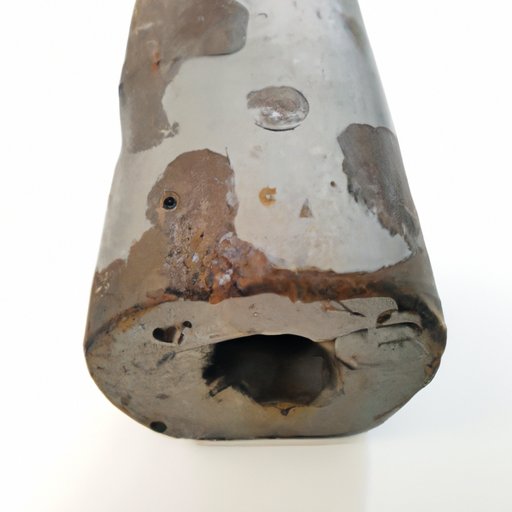Introduction
Galvanic corrosion is an electrolytic process that occurs when two different types of metal are placed together in an electrolyte solution. When this happens, the electrons move from the more active metal (the anode) to the less active metal (the cathode), resulting in corrosion. It is important to understand this phenomenon, as it can cause significant damage to structures made with metals such as aluminum and steel.
Aluminum and steel are two of the most commonly used metals in engineering and construction. They are also highly susceptible to galvanic corrosion when placed in contact with one another. Therefore, it is important to take steps to prevent galvanic corrosion between aluminum and steel in order to ensure the integrity of the structure.
Use a Barrier Material
One effective way to prevent galvanic corrosion between aluminum and steel is to use a barrier material. A barrier material is a non-conductive material that can be used to separate the two metals and prevent them from coming into direct contact with one another. Common barrier materials include rubber, plastic, and Teflon tape.
When using a barrier material, it is important to make sure that the material is securely attached to both the aluminum and steel surfaces. This will ensure that the barrier material does not become dislodged, allowing the two metals to come into direct contact. Additionally, it is important to make sure that the gap between the two metals is sufficiently small so that electrolyte solutions cannot pass through.

Coat Surfaces with Protective Layer
Another effective way to prevent galvanic corrosion between aluminum and steel is to apply a protective coating to the surfaces of both metals. This will create a barrier that will help to prevent corrosion by preventing the two metals from coming into direct contact. Common protective coatings include paint, epoxy, and zinc plating.
When applying a protective coating, it is important to make sure that the coating is applied evenly and completely. Any gaps or voids in the coating may allow the two metals to come into direct contact, which could lead to corrosion. Additionally, it is important to make sure that the coating is compatible with both the aluminum and steel surfaces so that it does not react with either metal.
Isolate Materials with Insulating Material
A third effective way to prevent galvanic corrosion between aluminum and steel is to use an insulating material to separate the two metals. Insulating materials, such as ceramic fiberboard, are non-conductive and can be used to create an air gap between the two metals. This air gap will help to prevent electrolyte solutions from passing between the two metals, thus preventing galvanic corrosion.
When using an insulating material, it is important to make sure that the material is securely attached to both the aluminum and steel surfaces. Additionally, it is important to make sure that the gap between the two metals is sufficiently small so that electrolyte solutions cannot pass through. Finally, it is important to make sure that the material is compatible with both the aluminum and steel surfaces so that it does not react with either metal.

Apply Chemical Inhibitor to Surface
A fourth effective way to prevent galvanic corrosion between aluminum and steel is to apply a chemical inhibitor to the surfaces of both metals. Chemical inhibitors are compounds that can be used to protect the surface of a metal from corrosion. Common chemical inhibitors include chromates, phosphates, and silicates.
When applying a chemical inhibitor, it is important to make sure that the inhibitor is compatible with both the aluminum and steel surfaces so that it does not react with either metal. Additionally, it is important to make sure that the inhibitor is applied evenly and completely so that any gaps or voids do not allow the two metals to come into direct contact.
Increase Distance between Materials
A fifth effective way to prevent galvanic corrosion between aluminum and steel is to increase the distance between the two metals. By increasing the distance between the two metals, the possibility of electrolyte solutions passing between them is reduced, thus reducing the risk of corrosion.
When increasing the distance between the two metals, it is important to consider the implications of such a decision. As the distance between the two metals increases, the strength of the connection between them may be weakened, which could affect the structural integrity of the structure.

Connect Aluminum and Steel Parts with Stainless Steel Fasteners
Finally, a sixth effective way to prevent galvanic corrosion between aluminum and steel is to connect the two metals with stainless steel fasteners. Stainless steel is an alloy that contains both iron and chromium. These two elements combine to form a material that is highly resistant to corrosion, making it ideal for connecting aluminum and steel parts.
When using stainless steel fasteners, it is important to make sure that they are properly installed. Additionally, it is important to make sure that the fasteners are compatible with both the aluminum and steel parts so that they do not corrode or react with either metal.
Conclusion
Galvanic corrosion is a serious problem that can occur when two dissimilar metals are in contact with one another. To prevent galvanic corrosion between aluminum and steel, it is important to take precautions such as using a barrier material, coating surfaces with a protective layer, isolating materials with an insulating material, applying a chemical inhibitor to the surface, increasing the distance between the materials, and connecting the aluminum and steel parts with stainless steel fasteners.
By taking these steps, it is possible to reduce the risk of galvanic corrosion and ensure the integrity of the structure. It is important to remember, however, that no matter what measures are taken, there is still a risk of galvanic corrosion occurring between aluminum and steel.

